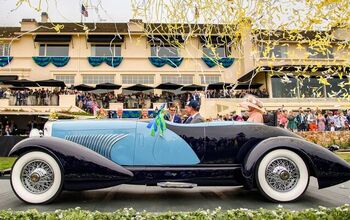QOTD: What's Your Lower Limit?

No, this isn’t a question about resurgent — and somewhat ironic — demand for the Geo Metro and its tepid ilk, but Timothy Cain probably has something to say about the chances of success of a latter-day model. Rather, this is a question about the way you drive, and the decisions of those who govern us.
We’re all cool with who we take orders from, right? Okay, good. Lest this writer stand accused of not getting to the point in a swift and efficient manner, here goes — are you willing to get to your destination in a less swift manner?
Maybe some explanation is in order. In my online journeys yesterday, a somewhat ranty piece published on the National Motorists Association blog caught my eye, and with good reason. The title read “I Can’t Drive 25.”
Apparently there’s a push in the Greater Boston Area town of Saugus to lower the municipality’s default speed limit from 30 mph to 25 mph, a law Boston itself passed a couple of years back. To our Canadian readers, that means a reduction on city streets (unless otherwise posted) from 48.3 km/h to 40 km/h. This would be in the interest of public safety, of course.
Few cities have escaped the movement to reduce speed limits in order to create safer, more “liveable” streets, often in the complete absence of other road infrastructure improvements. Lower the default limit and paradise blooms, apparently. Tulips burst forth from cracked sidewalks. Sometimes it works; other times it just leads to increased ticket revenue. In fairness, a 2018 Insurance Institute for Highway Safety study found that, in Boston, the speed limit reduction brought about a 29.3 percent decline in the number of speeding vehicles travelling 35 mph or higher. Whether that brought about a reduced accident/injury rate remains to be seen, though other studies say yes, it will.
In my neck of the woods, and indeed in Boston (and other cities too), there’s pressure to go even lower: 20 mph (32.2 km/k) in Boston and 30 km/h (18.6 mph) in my city. Which begs the question: how slow are you willing to drive before pushing back — if indeed you would?
In some instances, the backers of such speed limit changes are less concerned with public safety and more interested in disincentivizing/punishing driving as a whole, though they hold their true motivation close to the vest. Such proponents are the ones who can be heard lamenting the fact that roads exist, as they encourage car use (as well as make bus transit and the delivery of food to their local store possible). As if roads weren’t messy, dangerous places that existed long before the advent of the automobile. These people rarely leave the downtown portion of their respective cities, unless it’s to go to the airport for a flight to the downtown portion of another major city, from which they will return with grand stories about how people in Northern Europe and Asia do things (the proper way).
My father worked for years as a traffic engineer, mapping out intersection designs and traffic light signal timing for the city that employed him. One thing that annoys engineers more than anything else is when a city politico, eager to grease a squeaky cadre of constituents, propels a speed limit change through city council in the interests of career salvation. Engineers design roads with efficiency and safety in mind. Do pedestrians have ample time to cross the street, and places in which to do so? Will the road handle the anticipated traffic flow at peak times without exceeding capacity? On and on the considerations go.
If a public roadway is marked 30 mph or 45 mph or 65 mph, it’s because it was engineered and designed to carry vehicles at that speed. Stopping distances and buffer zones between vehicles and between vehicle and curb were considered. Thus, lowering the speed limit on certain roads means the city spent unnecessary money during its construction. It also means motorists are driving on overbuilt roads that, by design, encourage a higher speed. Driving a divided, four-lane non-freeway roadway with long gaps between intersections feels normal at 50-60 mph, but lower the speed to 40 and something feels off. You feel like you’re hardly moving. There’s a divided, four-lane stretch with a curve near my house that carries an 18.6 mph (30 km/h) limit, and absolutely no one abides by it. They do, however, drop their speed somewhat, fearing the Man. Maybe that’s what it’s all about.
A speed camera on that stretch would amount to a shakedown.
While streetscape improvements (speed bumps, bollards, lane reductions, curb bulb-outs) can make a reduced street speed feel more natural, not all cities and towns have the cash to make that happen. Changing a sign is far cheaper.
In the absence of a narrower, more obstacle filled street designed to slow you down in a more organic fashion, do you find a very low limit to be a distraction in itself? Maybe 25 mph is doable, but 18.6 mph? An exceedingly low speed would require this writer to drive along in second gear or the bottom of third, neither of which is ideal for smoothness and consistency of speed. As it doesn’t feel natural, it’s quite possible your eyes might spend more time on your gauge cluster and not on the road ahead.
What’s your take on this matter? How slow are you willing to go?
[Image: RU2 Systems]

More by Steph Willems
Latest Car Reviews
Read moreLatest Product Reviews
Read moreRecent Comments
- Kmars2009 I rented one last fall while visiting Ohio. Not a bad car...but not a great car either. I think it needs a new version. But CUVs are King... unfortunately!
- Ajla Remember when Cadillac introduced an entirely new V8 and proceeded to install it in only 800 cars before cancelling everything?
- Bouzouki Cadillac (aka GM!!) made so many mistakes over the past 40 years, right up to today, one could make a MBA course of it. Others have alluded to them, there is not enough room for me to recite them in a flowing, cohesive manner.Cadillac today is literally a tarted-up Chevrolet. They are nice cars, and the "aura" of the Cadillac name still works on several (mostly female) consumers who are not car enthusiasts.The CT4 and CT5 offer superlative ride and handling, and even performance--but, it is wrapped in sheet metal that (at least I think) looks awful, with (still) sub-par interiors. They are niche cars. They are the last gasp of the Alpha platform--which I have been told by people close to it, was meant to be a Pontiac "BMW 3-series". The bankruptcy killed Pontiac, but the Alpha had been mostly engineered, so it was "Cadillac-ized" with the new "edgy" CTS styling.Most Cadillacs sold are crossovers. The most profitable "Cadillac" is the Escalade (note that GM never jack up the name on THAT!).The question posed here is rather irrelevant. NO ONE has "a blank check", because GM (any company or corporation) does not have bottomless resources.Better styling, and superlative "performance" (by that, I mean being among the best in noise, harshness, handling, performance, reliablity, quality) would cost a lot of money.Post-bankruptcy GM actually tried. No one here mentioned GM's effort to do just that: the "Omega" platform, aka CT6.The (horribly misnamed) CT6 was actually a credible Mercedes/Lexus competitor. I'm sure it cost GM a fortune to develop (the platform was unique, not shared with any other car. The top-of-the-line ORIGINAL Blackwing V8 was also unique, expensive, and ultimately...very few were sold. All of this is a LOT of money).I used to know the sales numbers, and my sense was the CT6 sold about HALF the units GM projected. More importantly, it sold about half to two thirds the volume of the S-Class (which cost a lot more in 201x)Many of your fixed cost are predicated on volume. One way to improve your business case (if the right people want to get the Green Light) is to inflate your projected volumes. This lowers the unit cost for seats, mufflers, control arms, etc, and makes the vehicle more profitable--on paper.Suppliers tool up to make the number of parts the carmaker projects. However, if the volume is less than expected, the automaker has to make up the difference.So, unfortunately, not only was the CT6 an expensive car to build, but Cadillac's weak "brand equity" limited how much GM could charge (and these were still pricey cars in 2016-18, a "base" car was ).Other than the name, the "Omega" could have marked the starting point for Cadillac to once again be the standard of the world. Other than the awful name (Fleetwood, Elegante, Paramount, even ParAMOUR would be better), and offering the basest car with a FOUR cylinder turbo on the base car (incredibly moronic!), it was very good car and a CREDIBLE Mercedes S-Class/Lexus LS400 alternative. While I cannot know if the novel aluminum body was worth the cost (very expensive and complex to build), the bragging rights were legit--a LARGE car that was lighter, but had good body rigidity. No surprise, the interior was not the best, but the gap with the big boys was as close as GM has done in the luxury sphere.Mary Barra decided that profits today and tomorrow were more important than gambling on profits in 2025 and later. Having sunk a TON of money, and even done a mid-cycle enhancement, complete with the new Blackwing engine (which copied BMW with the twin turbos nestled in the "V"!), in fall 2018 GM announced it was discontinuing the car, and closing the assembly plant it was built in. (And so you know, building different platforms on the same line is very challenging and considerably less efficient in terms of capital and labor costs than the same platform, or better yet, the same model).So now, GM is anticipating that, as the car market "goes electric" (if you can call it that--more like the Federal Government and EU and even China PUSHING electric cars), they can make electric Cadillacs that are "prestige". The Cadillac Celestique is the opening salvo--$340,000. We will see how it works out.
- Lynn Joiner Lynn JoinerJust put 2,000 miles on a Chevy Malibu rental from Budget, touring around AZ, UT, CO for a month. Ran fine, no problems at all, little 1.7L 4-cylinder just sipped fuel, and the trunk held our large suitcases easily. Yeah, I hated looking up at all the huge FWD trucks blowing by, but the Malibu easily kept up on the 80 mph Interstate in Utah. I expect a new one would be about a third the cost of the big guys. It won't tow your horse trailer, but it'll get you to the store. Why kill it?
- Lynn Joiner Just put 2,000 miles on a Chevy Malibu rental from Budget, touring around AZ, UT, CO for a month. Ran fine, no problems at all, little 1.7L 4-cylinder just sipped fuel, and the trunk held our large suitcases easily. Yeah, I hated looking up at all the huge FWD trucks blowing by, but the Malibu easily kept up on the 80 mph Interstate in Utah. I expect a new one would be about a third the cost of the big guys. It won't tow your horse trailer, but it'll get you to the store. Why kill it?



































Comments
Join the conversation
The only place I have dutifully obeyed the speed limit, even though it some instances drops to 5 MPH, is county route 340 in far northwestern Maui.
As others have mentioned it is clear that many do not understand the physics of time and distance. In the area that I live the limit is 25 because there are children playing, bicyclists, horses, dogs, lots of driveways and things that restrict vision like trees, fences, and curves. The houses that are farthest away, from where the speed limit changes from 45 to 25, are about 1/2 mile. Yet there are many who drive at 40-45 so they can get home what? 30 secs quicker. Every other year the Sheriff or Highway Patrol put one of those speed trailers, in the photo at the top of the page, on the road about 1/8 mile past the 25 sign. I would frequently see someone driving in front of me get the "Your Speed" 40 (+). Even on a trip of 30 miles going 70-75 vs 65 will be only a few minutes faster.